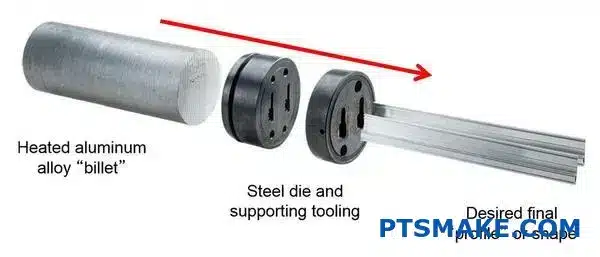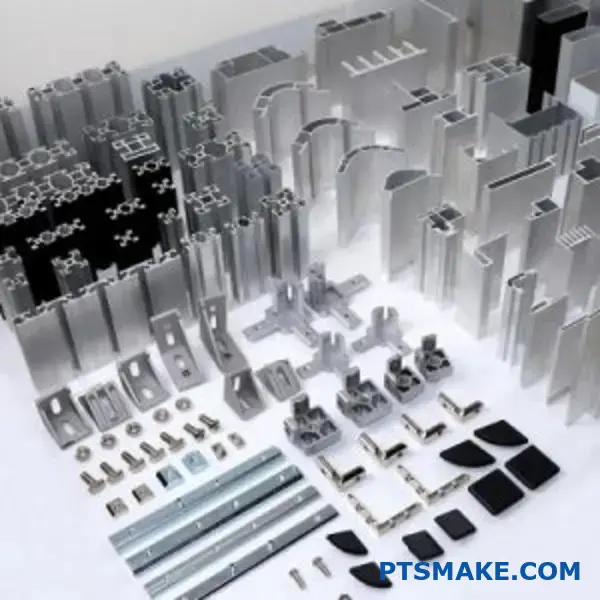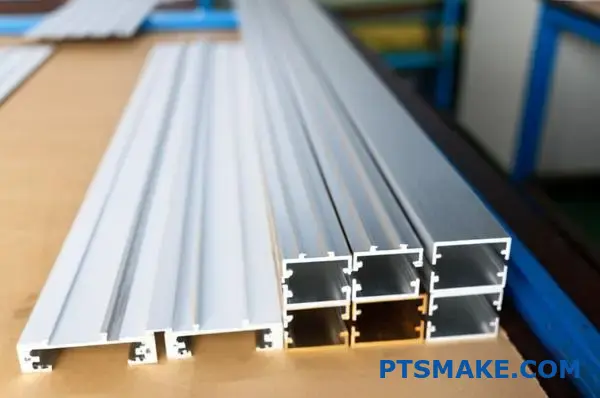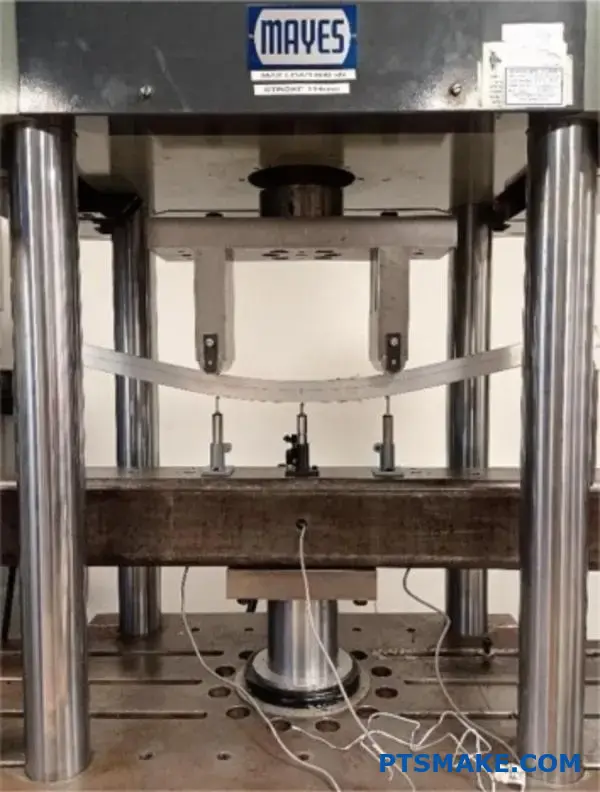Are you struggling to choose the right aluminum alloy for your critical aerospace or defense applications? Many engineers face this challenge, risking project failure by selecting materials that can’t withstand high-stress environments or meet precise performance requirements.
Aluminum 7075 is a high-strength zinc-based alloy known for its exceptional strength-to-weight ratio, excellent fatigue resistance, and good machinability. Primarily used in aerospace, defense, and high-stress applications, it offers superior performance where standard aluminum alloys would fail.
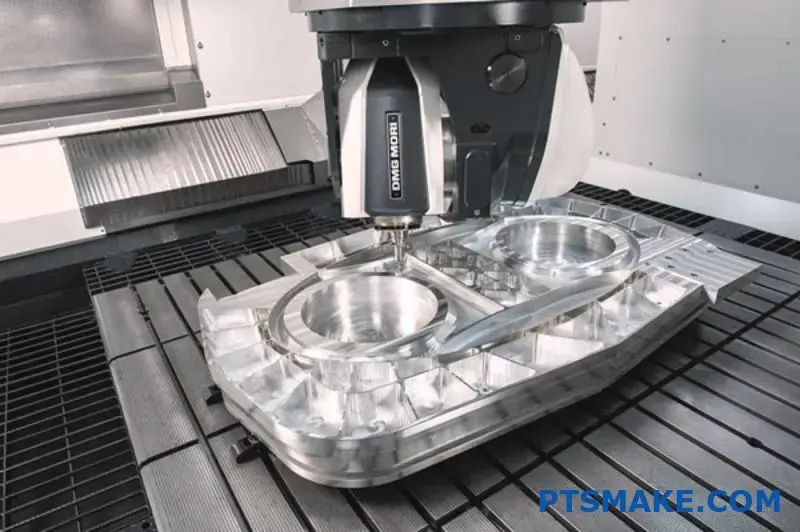
In my years at PTSMAKE, I’ve worked with many clients who initially overlooked aluminum 7075 for their critical applications. This powerful alloy delivers strength comparable to many steels but at just one-third the weight. If you’re designing components that need to perform under extreme conditions while maintaining minimal weight, the information below will help you understand why 7075 might be the perfect solution for your next project.
Is 7075 Aluminum Stronger Than 6061?
Have you ever found yourself staring at material specifications, torn between choosing 7075 and 6061 aluminum for your critical project? That frustrating moment when you need the perfect balance of strength, weight, and cost, but the technical datasheets seem to blur together in a confusing mess?
Yes, 7075 aluminum is significantly stronger than 6061. 7075 offers nearly twice the tensile strength (83,000 psi vs. 45,000 psi) and superior yield strength, making it ideal for high-stress applications in aerospace and defense, while 6061 provides better corrosion resistance and weldability at a lower cost.
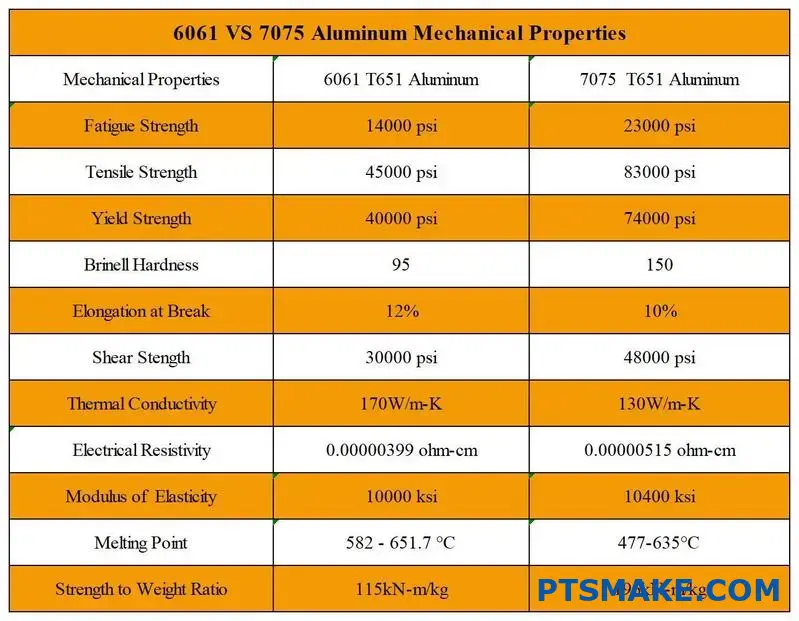
Understanding Aluminum Alloy Designations
Before diving into the strength comparison, it’s important to understand what these numbers actually mean. The 4-digit designation system for aluminum alloys was developed by the Aluminum Association to classify different aluminum compositions and their properties.
The first digit indicates the main alloying element. Both 6061 and 7075 are wrought alloys, with "6" signifying that magnesium and silicon are the primary alloying elements, while "7" indicates zinc as the principal addition. The second digit denotes modifications to the original alloy or impurity limits, while the last two digits identify the specific alloy within the series.
Mechanical Properties Comparison
When comparing strength characteristics, several key metrics need evaluation:
Tensile Strength
7075 aluminum significantly outperforms 6061 in tensile strength, particularly in the T6 temper condition:
| Property | 7075-T6 | 6061-T6 | Difference |
|---|---|---|---|
| Ultimate Tensile Strength | 83,000 psi (572 MPa) | 45,000 psi (310 MPa) | ~84% stronger |
| Yield Strength | 73,000 psi (503 MPa) | 40,000 psi (276 MPa) | ~83% stronger |
| Elongation at Break | 11% | 12% | Similar ductility |
In my experience working with aerospace components at PTSMAKE, this superior tensile strength makes 7075 the preferred choice for structurally critical applications where failure isn’t an option.
Hardness Comparison
Hardness correlates strongly with wear resistance and machinability:
| Alloy | Brinell Hardness | Rockwell B |
|---|---|---|
| 7075-T6 | 150 | 87 |
| 6061-T6 | 95 | 60 |
This substantial difference in hardness explains why 7075 is often specified for components subjected to high wear conditions.
Fatigue Resistance
For components experiencing cyclic loading, fatigue strength becomes critical. 7075-T6 provides approximately 23,000 psi (159 MPa) fatigue strength at 5×10^8 cycles, compared to 6061-T6’s 14,000 psi (96 MPa). This endurance limit1 advantage makes 7075 particularly valuable in applications like aircraft structural components and high-performance vehicle parts.
Chemical Composition and Its Impact on Strength
The chemical makeup directly influences performance characteristics:
| Element | 7075 (%) | 6061 (%) | Effect on Properties |
|---|---|---|---|
| Zinc | 5.1-6.1 | 0.25 max | Primary strengthening element in 7075 |
| Magnesium | 2.1-2.9 | 0.8-1.2 | Contributes to strength and corrosion resistance |
| Copper | 1.2-2.0 | 0.15-0.4 | Increases strength but reduces corrosion resistance |
| Silicon | 0.4 max | 0.4-0.8 | Primary alloying element with Mg in 6061 |
The higher zinc content in 7075 creates more precipitation hardening potential, while the copper addition further enhances strength at the expense of some corrosion resistance.
Application Considerations Beyond Strength
While 7075 aluminum is clearly stronger, strength isn’t the only factor that matters in material selection:
Machinability
Despite its higher hardness, 7075 aluminum machines exceptionally well. At PTSMAKE, we’ve found that with proper cutting parameters, 7075 can often be machined more efficiently than 6061 because it produces cleaner chips and allows for aggressive material removal rates. However, tool wear is typically higher with 7075.
Weldability
6061 has a distinct advantage in weldability. It’s readily weldable using conventional methods like TIG and MIG. In contrast, 7075 is considered one of the more challenging aluminum alloys to weld due to its high zinc content, which contributes to hot cracking susceptibility.
Corrosion Resistance
6061 generally offers better corrosion resistance, particularly in marine environments. 7075, especially with its higher copper content, requires additional protection like anodizing or conversion coating in corrosive environments.
Cost Considerations
The price difference between these alloys can be significant, with 7075 typically commanding a 30-50% premium over 6061. This cost difference makes 6061 more economical for applications where its moderate strength is sufficient.
Making the Right Choice for Your Application
The decision between these alloys should be application-driven:
- Choose 7075 when: Maximum strength and fatigue resistance are paramount, weight is critical, and the higher cost is justified by performance requirements.
- Choose 6061 when: Moderate strength is sufficient, weldability is required, corrosion resistance is important, or budget constraints are significant.
In precision manufacturing, there’s rarely a one-size-fits-all solution. Through careful material selection based on specific application requirements, we can optimize both performance and cost-effectiveness.
What Is 7075 Aluminum Used For?
Have you ever wondered why certain aerospace components don’t fail under extreme stress? Or why high-performance mountain bikes can take such punishment without breaking? The seemingly magical material behind these engineering marvels often goes unnoticed, yet it’s crucial for countless applications where failure isn’t an option.
7075 aluminum is primarily used in aerospace, military, transportation, and sporting equipment applications where high strength-to-weight ratio is critical. This aluminum alloy offers exceptional mechanical properties, including superior strength comparable to many steels while maintaining the lightweight characteristics of aluminum.
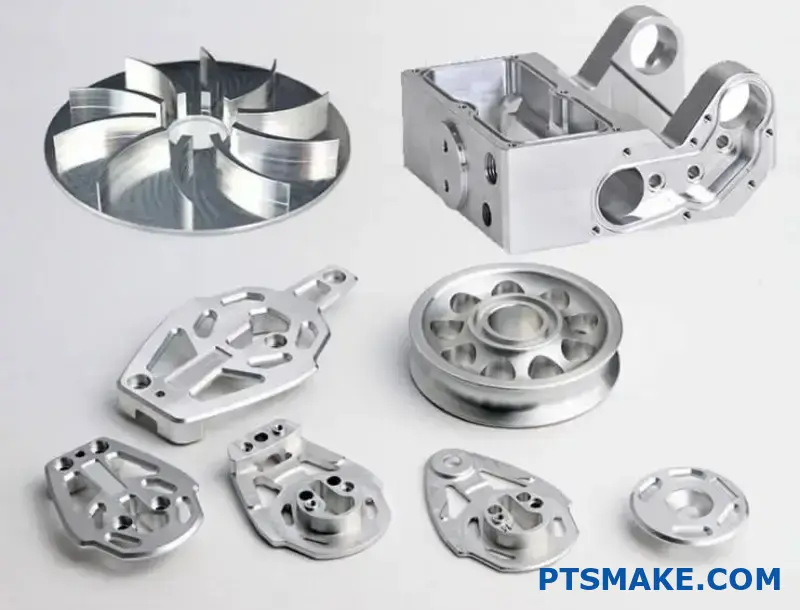
Key Applications of 7075 Aluminum
Aerospace Industry Applications
The aerospace industry was actually the birthplace of 7075 aluminum. Developed in the 1940s, this alloy quickly became the go-to material for aircraft structural components. When you’re building something that needs to be both lightweight and incredibly strong, 7075 aluminum is often the perfect solution.
In modern aircraft, you’ll find this high-strength alloy in:
- Fuselage frames and bulkheads
- Wing spars and stringers
- Landing gear components
- Structural supports
What makes 7075 particularly valuable for aerospace applications is its excellent fatigue resistance. Aircraft components experience countless cycles of stress during their operational lifetime, and this alloy maintains its structural integrity through these repeated loading cycles better than many alternative materials.
Military and Defense Applications
The military sector leverages 7075 aluminum’s unique properties for various applications where performance cannot be compromised. During my work with defense contractors at PTSMAKE, I’ve seen firsthand how crucial this alloy is for:
- Armor plating components
- Military aircraft structures
- Missile components
- Tactical equipment
The combination of high tensile strength and good ballistic resistance2 makes 7075 aluminum particularly valuable for protective applications. While it’s not typically used as the primary armor material, it serves as excellent structural support in composite armor systems.
Transportation Industry Uses
Beyond aerospace, the transportation industry widely adopts 7075 aluminum where weight reduction without strength compromise is essential:
| Transportation Application | Benefits of 7075 Aluminum |
|---|---|
| High-performance auto parts | Improved fuel efficiency, enhanced acceleration |
| Racing car components | Superior strength-to-weight ratio, better handling |
| Mountain bike frames | Durability with lightweight construction |
| Marine components | Corrosion resistance with tempering |
The automotive industry, especially in racing and high-performance vehicles, uses 7075 components to reduce weight without sacrificing structural integrity. While it’s typically more expensive than other aluminum alloys, the performance benefits often justify the cost in specialized applications.
Sporting Equipment Applications
The sporting goods industry has embraced 7075 aluminum for premium equipment where performance matters most:
- Rock climbing equipment (carabiners, ice axes)
- High-end archery components
- Baseball and softball bats
- Premium fishing reels and components
For these applications, the combination of strength, weight, and durability makes 7075 aluminum ideal. At PTSMAKE, we’ve produced precision components for sporting goods manufacturers who demand nothing less than perfect performance from their materials.
Manufacturing Considerations for 7075 Aluminum
Machining Challenges
While 7075 offers exceptional mechanical properties, it presents unique challenges during machining processes. The very hardness that makes it valuable also makes it more difficult to machine compared to softer aluminum alloys.
In my experience at PTSMAKE, successful machining of 7075 aluminum requires:
- Proper tool selection (carbide tools often perform best)
- Appropriate cutting speeds and feeds
- Effective cooling strategies to manage heat buildup
- Specialized fixturing to minimize workpiece movement
The material’s tendency to work-harden means that machining strategies must be carefully planned to avoid creating additional difficulties during the manufacturing process.
Heat Treatment Considerations
One of the most crucial aspects of working with 7075 aluminum is proper heat treatment. The most common temper is T6, which provides the optimal balance of strength and dimensional stability.
The typical heat treatment process involves:
- Solution heat treatment (heating to approximately 900°F)
- Quenching (rapid cooling)
- Artificial aging (controlled reheating)
This process dramatically transforms the material properties, increasing tensile strength from around 33,000 psi in the annealed condition to over 83,000 psi in the T6 condition. However, the process must be precisely controlled to avoid introducing dimensional changes that could affect final part tolerances.
Comparing 7075 Aluminum with Steel: Which Has Better Properties?
Have you ever been stuck trying to choose between aluminum 7075 and steel for your project? The struggle is real – balancing weight requirements against strength needs while staying within budget can feel like an impossible puzzle, especially when deadlines are looming.
While 7075 aluminum isn’t universally stronger than steel, it offers superior strength-to-weight ratio. A piece of 7075 aluminum is approximately one-third the weight of steel with comparable strength in certain applications, making it ideal for aerospace and high-performance applications where weight matters.

Breaking Down the Properties: 7075 Aluminum vs. Steel
When comparing materials like 7075 aluminum and steel, we need to consider multiple properties beyond just looking at raw strength numbers. Having worked with both materials extensively in various precision manufacturing projects, I’ve learned that context matters tremendously.
Tensile Strength Comparison
The tensile strength of 7075-T6 aluminum (the most common temper) typically ranges from 74,000-78,000 psi (510-540 MPa). This is impressive for an aluminum alloy, but many steels surpass this:
| Material | Tensile Strength (psi) | Tensile Strength (MPa) |
|---|---|---|
| 7075-T6 Aluminum | 74,000-78,000 | 510-540 |
| Mild Steel (A36) | 58,000-80,000 | 400-550 |
| 4140 Steel (Heat Treated) | 150,000-165,000 | 1,035-1,140 |
| Stainless Steel 304 | 85,000 | 585 |
As you can see, while 7075 aluminum outperforms some mild steels, many steel alloys have significantly higher tensile strength. However, tensile strength alone doesn’t tell the complete story.
Strength-to-Weight Ratio: The Critical Factor
Where 7075 aluminum truly shines is its exceptional strength-to-weight ratio. With a density of only about 2.81 g/cm³ compared to steel’s 7.85 g/cm³, aluminum 7075 delivers remarkable strength at just one-third the weight.
For specific strength3 calculations:
- 7075-T6 Aluminum: ~196 kN·m/kg
- Steel (varies by type): ~154 kN·m/kg for high-strength steels
This property makes 7075 aluminum the material of choice at PTSMAKE when we’re manufacturing aerospace components, sporting equipment, or any application where weight reduction is critical without sacrificing structural integrity.
Yield Strength and Hardness
Yield strength indicates when a material begins to deform permanently. 7075-T6 aluminum has a yield strength of approximately 73,000 psi (503 MPa), which is comparable to many steels but lower than high-strength steel alloys.
For hardness, 7075-T6 aluminum typically measures 150 Brinell, while:
- Mild steel: 120 Brinell
- Heat-treated steel: 280-600 Brinell (depending on the alloy and treatment)
Environmental Performance Differences
Corrosion Resistance
Steel typically needs additional treatments or coatings to resist corrosion, while aluminum naturally forms an oxide layer that provides some inherent protection. However, 7075 aluminum is actually more susceptible to corrosion than many other aluminum alloys due to its high copper content.
In my manufacturing experience at PTSMAKE, we often recommend anodizing 7075 aluminum components or applying other protective finishes when they’ll be exposed to harsh environments. For steel components, galvanization or specialized coatings are typically necessary.
Temperature Performance
Steel generally maintains its structural properties better at extreme temperatures:
| Material | Low Temp Performance | High Temp Performance |
|---|---|---|
| 7075 Aluminum | Excellent down to cryogenic temps | Loses strength above 200°F (93°C) |
| Steel (typical) | Good at low temps | Maintains strength up to 1000°F (538°C) |
This temperature difference becomes critical in applications with high operating temperatures, where steel often remains the preferred choice despite its weight disadvantage.
Cost and Machinability Considerations
7075 aluminum is generally more expensive than common steels but offers excellent machinability. At PTSMAKE, we’ve found that the higher material cost of 7075 is often offset by:
- Reduced machining time and tool wear
- Lower transportation costs due to lighter weight
- Reduced energy consumption in mobile applications
- No need for painting (though anodizing is recommended)
The material choice ultimately depends on your specific application requirements. For aerospace, high-performance automotive, or sporting goods applications where weight is critical, 7075 aluminum often proves superior despite not having the absolute highest strength values of steel.
What Are the Advantages and Disadvantages of 7075 Aluminum?
Have you ever found yourself torn between material choices for a critical project? That moment when you need exceptional strength but worry about cost implications or corrosion resistance? Making the right material selection can mean the difference between project success and costly failure.
7075 aluminum offers outstanding strength-to-weight ratio and excellent fatigue resistance, but comes with higher costs and reduced weldability compared to other aluminum alloys. Its exceptional hardness makes it ideal for aerospace applications, while corrosion concerns can be addressed through proper treatment.
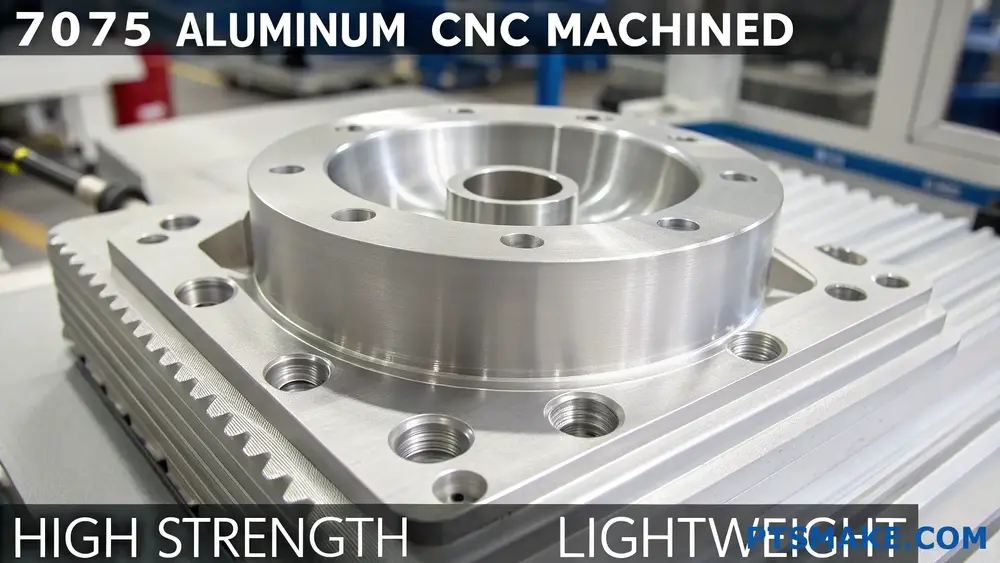
Advantages of 7075 Aluminum
Superior Strength-to-Weight Ratio
When comparing aluminum alloys, 7075 stands at the top of the pyramid for strength. With tensile strength comparable to many steels, it delivers this performance at just one-third the weight. This exceptional strength-to-weight ratio makes it invaluable in applications where weight reduction is critical but strength cannot be compromised.
In my work with aerospace clients at PTSMAKE, I’ve seen firsthand how this material property translates to fuel savings and increased payload capacity. The material achieves this through its zinc-based composition, which creates a unique precipitation hardening4 mechanism that strengthens the aluminum’s microstructure.
Excellent Fatigue Resistance
Another standout property of 7075 aluminum is its remarkable fatigue resistance. Components subjected to repeated loading and unloading cycles typically fail much sooner than their static load ratings would suggest. However, 7075 maintains its integrity impressively well under these conditions.
This property is particularly valuable in applications with vibration or cyclical loading, such as:
- Aircraft structural components
- High-performance automotive parts
- Sporting equipment (bicycle frames, climbing hardware)
- Military equipment
High Machinability
Despite its hardness, 7075 aluminum machines quite well when proper techniques are employed. This makes it suitable for creating intricate components with tight tolerances. At PTSMAKE, we regularly CNC machine 7075 components with features requiring ±0.005mm precision.
The material cuts cleanly with proper tooling and responds well to both traditional and modern machining approaches. This machinability, combined with its strength properties, makes it ideal for complex precision components.
Disadvantages of 7075 Aluminum
Cost Considerations
One significant drawback of 7075 aluminum is its higher cost compared to more common aluminum alloys. The price premium exists for several reasons:
- More complex alloying process
- Higher demand in specialized industries
- More stringent quality control requirements
This table compares approximate relative costs of common aluminum alloys:
| Aluminum Alloy | Relative Cost Index |
|---|---|
| 1100 (pure) | 1.0 |
| 6061 | 1.3-1.5 |
| 2024 | 1.7-1.9 |
| 7075 | 2.0-2.4 |
While this cost difference can be significant for large production runs, it’s often justified by the performance benefits in critical applications.
Limited Weldability
Perhaps the most significant technical limitation of 7075 aluminum is its poor weldability. The high zinc content that gives it exceptional strength also makes it highly susceptible to weld cracking and strength reduction in heat-affected zones.
This limitation means that 7075 components typically require alternative joining methods:
- Mechanical fastening (bolts, rivets)
- Adhesive bonding
- Specialized processes like friction stir welding
In some manufacturing scenarios, this limitation dictates design changes or forces the use of alternative materials when welded assemblies are required.
Corrosion Vulnerability
While all aluminum alloys form a natural oxide layer that provides basic corrosion protection, 7075 is more susceptible to certain types of corrosion than other aluminum alloys, particularly:
- Stress corrosion cracking
- Exfoliation corrosion
- Galvanic corrosion when in contact with certain metals
This vulnerability can be mitigated through proper surface treatments like anodizing, alodining, or applying protective coatings. At PTSMAKE, we typically recommend anodizing 7075 components that will be exposed to harsh environments, which adds a layer of protection while maintaining dimensional accuracy.
Application-Specific Considerations
The suitability of 7075 aluminum ultimately depends on your specific application requirements. I find it helpful to consider these factors when evaluating whether 7075 is the right choice:
Ideal Applications for 7075 Aluminum
The material excels in scenarios requiring:
- Maximum strength with minimal weight
- Good fatigue resistance
- Excellent machinability for complex geometries
- No welding requirements
Common applications include:
- Aircraft structural components
- Defense equipment
- High-end sporting goods
- Precision machine parts
When to Choose Alternatives
Consider other alloys when your application involves:
- Extensive welding requirements (consider 6061 or 5052)
- Severe corrosive environments without surface protection
- Budget constraints for large production runs
- Need for high electrical conductivity (consider 1100 or 6101)
By carefully evaluating these factors against your specific requirements, you can make an informed decision about whether 7075 aluminum is the right material for your project.
What Is the Strongest Grade of Aluminium?
Have you ever worked on a project that required extreme strength in aluminum, only to be overwhelmed by the countless alloy options? Ever found yourself wondering if you’re using the right grade when structural integrity and safety are non-negotiable?
The strongest commercially available grade of aluminum is 7075-T6. This high-strength aluminum alloy contains zinc as its primary alloying element and offers a tensile strength of up to 83,000 psi (572 MPa), making it ideal for aerospace, military, and high-stress applications.
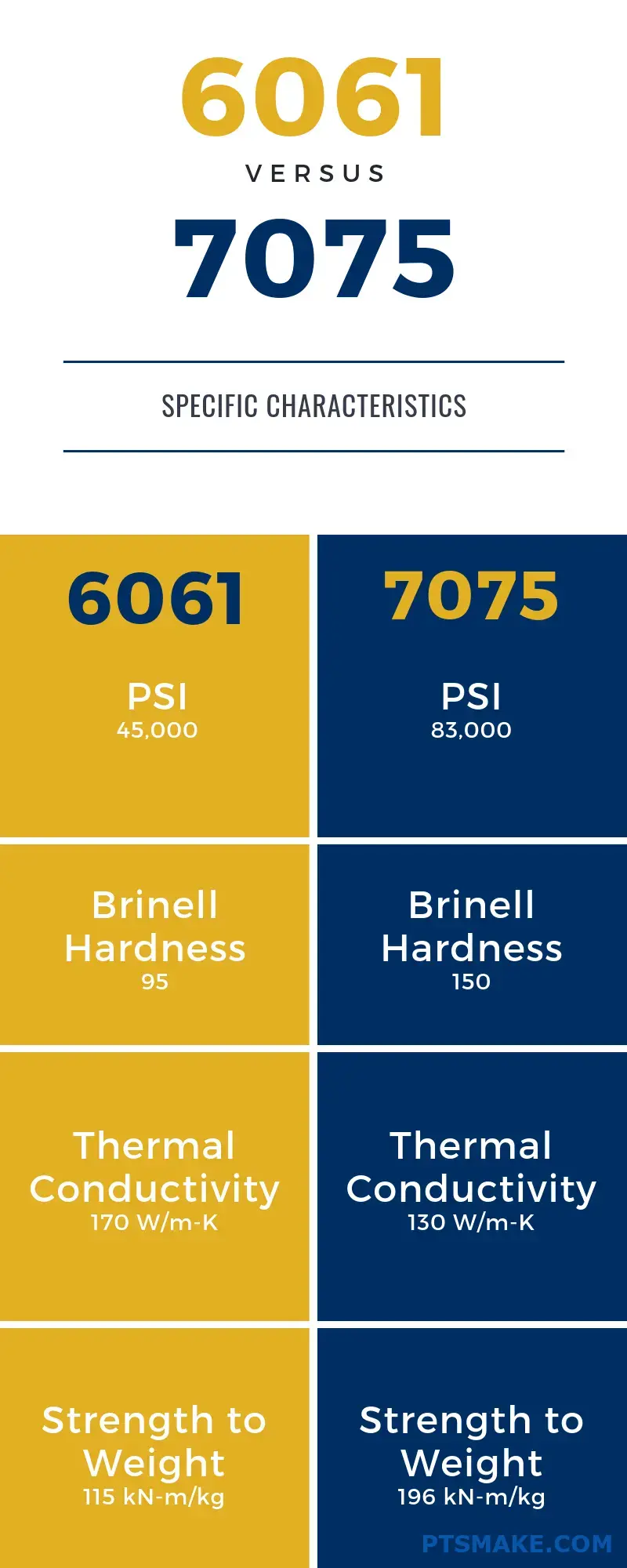
Understanding 7075 Aluminum’s Superior Strength Characteristics
When discussing high-performance aluminum alloys, 7075 consistently ranks at the top for strength. As someone who’s worked extensively with various metals for precision manufacturing, I’ve seen 7075 aluminum outperform most other aluminum grades in demanding applications.
The exceptional strength of 7075 aluminum comes from its unique composition. It contains approximately 5.1-6.1% zinc, 2.1-2.9% magnesium, 1.2-2.0% copper, and smaller amounts of chromium, manganese, and titanium. This zinc-rich formula creates an alloy that can be heat-treated to achieve outstanding mechanical properties.
The T6 temper designation (7075-T6) indicates a specific heat treatment process that maximizes the alloy’s strength. This process involves solution heat treatment followed by artificial aging. The result is an aluminum alloy with tensile strength comparable to many steels but at just one-third the weight.
Mechanical Properties That Set 7075 Apart
The impressive mechanical properties of 7075-T6 aluminum make it stand out from other grades:
| Property | 7075-T6 Value | Comparison to 6061-T6 |
|---|---|---|
| Tensile Strength | 83,000 psi (572 MPa) | ~1.8x stronger |
| Yield Strength | 73,000 psi (503 MPa) | ~2x stronger |
| Hardness (Brinell) | 150 HB | ~1.9x harder |
| Fatigue Strength | 23,000 psi (159 MPa) | ~1.6x better |
These numbers tell a compelling story – 7075-T6 offers nearly twice the strength of the widely used 6061-T6 alloy while maintaining aluminum’s lightweight advantage over steel.
Applications Demanding the Highest Strength Aluminum
Aerospace and Defense Uses
The aerospace industry was the original driving force behind 7075’s development during the 1940s. Today, this alloy continues to be crucial for:
- Aircraft structural components
- Military equipment and armor plating
- Missile components
- Fuselage frames and bulkheads
At PTSMAKE, I’ve seen numerous aerospace projects specify 7075 aluminum for components where failure isn’t an option. The alloy’s excellent strength-to-weight ratio makes it invaluable for reducing aircraft weight while maintaining structural integrity.
Sporting Equipment Requiring Maximum Performance
The exceptional properties of 7075 aluminum have made it popular in high-performance sporting equipment:
- Mountain bike frames and components
- Climbing equipment (carabiners, ice axes)
- Professional archery risers
- High-end lacrosse sticks
Sports equipment manufacturers value 7075’s ability to withstand intense forces while remaining lightweight, giving athletes a competitive edge.
Limitations of 7075 Aluminum Despite Its Strength
While 7075 offers unmatched strength, it’s not suitable for every application. Understanding its limitations is crucial for proper material selection:
Corrosion Resistance Challenges
One significant drawback of 7075 is its relatively poor corrosion resistance compared to other aluminum alloys, particularly the 5000 and 6000 series. The high copper content makes it susceptible to stress corrosion cracking5 and exfoliation corrosion, especially in marine environments.
In my experience with precision machining, we often recommend additional protective treatments for 7075 components exposed to corrosive environments:
- Anodizing (Type II or Type III)
- Alodine chromate conversion coating
- Primer and paint systems
- Regular maintenance and inspection protocols
Fabrication and Weldability Considerations
Another limitation is fabrication difficulty. The very properties that give 7075 its strength also make it:
- More difficult to machine (requiring specialized tooling)
- Challenging to weld using conventional methods
- More prone to warping during heat treatment
- Generally more expensive than other aluminum grades
For complex geometries requiring welding, we often suggest alternative alloys like 6061 or composite design approaches to avoid these limitations.
Comparing 7075 to Other High-Strength Aluminum Alloys
While 7075 is generally regarded as the strongest aluminum alloy, several other high-performance options deserve consideration:
| Alloy | Tensile Strength | Key Advantages | Common Applications |
|---|---|---|---|
| 7075-T6 | 83,000 psi | Highest strength | Aerospace, military |
| 2024-T3 | 65,000 psi | Better fatigue resistance | Aircraft structures |
| 7068-T6511 | 97,000 psi | Highest specialty strength | Competition shooting |
| 6061-T6 | 45,000 psi | Better corrosion resistance | General purpose |
| 5083-H321 | 46,000 psi | Superior marine corrosion resistance | Shipbuilding, marine |
The 7068 alloy deserves special mention as a specialized variant that can exceed 7075’s strength in certain forms, though it’s less widely available and significantly more expensive, making it impractical for most commercial applications.
Safety Concerns and Risk Management of 7075 Aluminum Welding?
Have you ever attempted to weld 7075 aluminum only to end up with cracked welds and a frustrated sigh? Or perhaps you’ve wondered why your workshop supervisor strictly forbids welding this particular alloy despite its popularity in aerospace applications?
Welding 7075 aluminum involves significant safety risks including toxic fume generation, fire hazards due to low melting points, and potential structural failures. Proper ventilation, specialized PPE, fire suppression systems, and comprehensive operator training are essential risk management strategies to mitigate these dangers.

Identifying Key Safety Hazards of 7075 Aluminum Welding
When it comes to welding 7075 aluminum, safety concerns extend far beyond the technical difficulties. In my experience working with aerospace and defense clients at PTSMAKE, I’ve observed several critical hazards that must be addressed before any welding attempt.
Toxic Fume Generation
7075 aluminum contains zinc (5.1-6.1%), magnesium (2.1-2.9%), and copper (1.2-2.0%) which vaporize at welding temperatures. These vapors can lead to a condition known as metal fume fever6 – a flu-like illness that occurs when welders inhale these metal-oxide fumes. Symptoms typically appear 4-12 hours after exposure and include:
- Fever and chills
- Metallic taste in mouth
- Fatigue and muscle aches
- Nausea and headaches
While typically temporary, repeated exposure can lead to long-term respiratory issues and increased susceptibility to lung infections.
Fire and Explosion Hazards
The relatively low melting point of aluminum (compared to steel) creates significant fire risks. Additionally, aluminum dust is highly combustible. During welding operations, these factors create dangerous conditions:
- Molten aluminum can ignite flammable materials at a distance
- Aluminum particles can form explosive mixtures with air
- Water contact with molten aluminum can cause violent steam explosions
Structural Integrity Risks
Perhaps most concerning from a safety perspective is the likelihood of post-weld structural failure. The heat-affected zone becomes significantly weaker than the parent material, creating potential failure points that may not be immediately visible. This poses serious safety risks in load-bearing applications.
Essential Safety Equipment for 7075 Aluminum Handling
When we work with 7075 aluminum at PTSMAKE, we implement comprehensive safety protocols even though we primarily machine rather than weld this material. For those who must attempt welding, these safety measures are non-negotiable:
Respiratory Protection Systems
Standard welding masks are insufficient for 7075 aluminum welding. Required equipment includes:
- Powered air-purifying respirator (PAPR) with appropriate metal fume filters
- External air supply systems for enclosed spaces
- Workplace air monitoring equipment to verify safe exposure levels
Specialized PPE Requirements
Beyond respiratory protection, specialized personal protective equipment is essential:
- Fire-resistant clothing covering all skin
- Specialized aluminum welding gloves (typically more insulative than standard welding gloves)
- Face shields with specific aluminum welding ratings
- Heat-resistant aprons and sleeves
Facility Safety Systems
The workspace itself requires significant safety modifications:
| Safety System | Purpose | Maintenance Requirement |
|---|---|---|
| Enhanced ventilation | Removes toxic fumes | Monthly filter changes, quarterly system inspection |
| Fire suppression | Contains potential aluminum fires | Annual inspection, specialized Class D fire extinguishers |
| Dedicated welding areas | Isolates welding operations | Daily cleanup, regular surface inspection |
| Emergency eyewash/shower | Addresses chemical exposure | Weekly testing, monthly full inspection |
Implementing Risk Management Strategies
Having supplied precision parts to aerospace companies for over 15 years, I’ve seen how proper risk management strategies make the difference between safe operations and workplace disasters.
Comprehensive Operator Training
Any personnel attempting to weld 7075 aluminum must receive specialized training beyond standard welding certification, including:
- Material-specific hazard recognition
- Emergency response procedures
- Health monitoring protocols
- Proper equipment maintenance
Engineering Controls and Workspace Design
Workspace design plays a critical role in mitigating risks:
- Downdraft tables to pull fumes away from operators’ breathing zones
- Thermal isolation barriers to reduce fire spread risk
- Designated hot work areas with non-combustible surfaces
- Emergency shutdown systems accessible from multiple locations
Medical Surveillance Programs
Due to the health risks associated with 7075 aluminum welding, implementing a medical surveillance program is advisable:
- Baseline pulmonary function testing for welders
- Regular blood testing for metal accumulation
- Hearing tests (aluminum welding can produce excessive noise)
- Annual comprehensive health assessments
Documentation and Compliance
Proper documentation is essential for both safety and legal compliance:
- Detailed safety procedures specific to 7075 aluminum
- Incident reporting and investigation protocols
- Regular safety audits and corrective action tracking
- Material Safety Data Sheet (MSDS) accessibility and training
Alternative Approaches to Reduce Safety Risks
At PTSMAKE, we often recommend alternative joining methods to clients who need to connect 7075 aluminum components. These alternatives significantly reduce safety risks while achieving the required structural integrity:
- Mechanical fastening (bolts, rivets, screws)
- Adhesive bonding with aerospace-grade epoxies
- Friction stir welding (which operates below the melting point)
- Design modifications to eliminate the need for joining heat-treated sections
By implementing these strategies, manufacturers can often achieve their design goals without introducing the significant safety risks associated with traditional welding of 7075 aluminum.
How Does Heat Treatment Affect Aluminum 7075 Properties?
Have you ever struggled with aluminum parts that didn’t perform as expected despite using premium alloys? Ever wondered why the same material can demonstrate dramatically different properties in different applications? The difference often lies not in the alloy itself, but in how it’s been heat treated – a critical factor many engineers overlook until performance issues emerge.
Heat treatment profoundly transforms aluminum 7075 properties by altering its microstructure. Through controlled heating and cooling processes like solution treatment, quenching, and aging, this alloy can achieve up to 3x higher strength, improved corrosion resistance, and enhanced machinability while sacrificing some ductility and toughness.
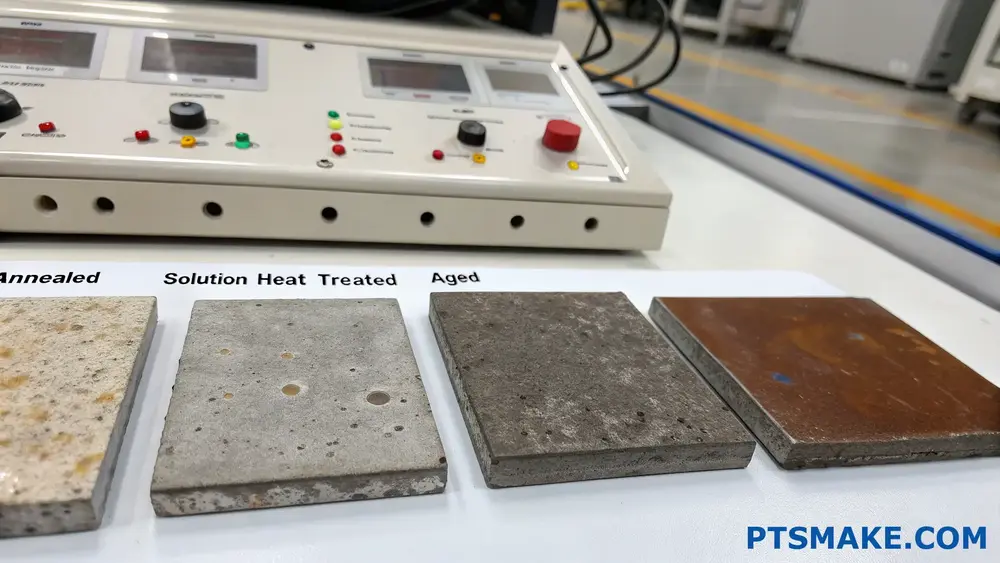
Understanding Heat Treatment Effects on Aluminum 7075
Heat treatment is a game-changer for aluminum 7075, which is why it’s so widely used in aerospace and high-stress applications. As someone who’s overseen countless precision machining projects, I’ve witnessed firsthand how the right heat treatment protocol can make the difference between part success and failure.
The fundamental purpose of heat treating 7075 aluminum is to optimize its mechanical properties for specific applications. By manipulating the alloy’s microstructure through controlled temperature changes, we can enhance its strength, hardness, and other characteristics to meet demanding requirements.
Key Heat Treatment Processes for Aluminum 7075
The heat treatment of aluminum 7075 typically involves several distinct processes:
- Solution Heat Treatment: Heating the alloy to approximately 900°F (480°C) to dissolve alloying elements into solid solution
- Quenching: Rapidly cooling the material, usually in water, to create a supersaturated solid solution
- Aging: Allowing precipitates to form within the microstructure, either naturally at room temperature or artificially at elevated temperatures
Each of these steps contributes to the final properties of the material. The most common tempers for 7075 aluminum include T6, T73, and T76, each offering different balances of properties.
Mechanical Property Changes Through Heat Treatment
Heat treatment dramatically alters the mechanical properties of 7075 aluminum. The following table shows typical property changes between annealed (O temper) and peak-aged (T6 temper) conditions:
| Property | 7075-O (Annealed) | 7075-T6 (Peak Aged) | Change Factor |
|---|---|---|---|
| Tensile Strength | 22 ksi (152 MPa) | 83 ksi (572 MPa) | 3.8× increase |
| Yield Strength | 14 ksi (97 MPa) | 73 ksi (503 MPa) | 5.2× increase |
| Elongation | 16% | 11% | 31% decrease |
| Hardness (Brinell) | 60 | 150 | 2.5× increase |
This transformation in properties occurs because of precipitation hardening7, where nanoscale particles form within the aluminum matrix, effectively blocking dislocation movement and strengthening the alloy.
Effects on Specific Material Properties
Strength and Hardness
The most dramatic effect of heat treatment on aluminum 7075 is the increase in strength and hardness. Through proper heat treatment, tensile strength can increase from around 22 ksi in the annealed condition to over 83 ksi in the T6 temper. This strengthening comes at a cost, however – the material typically loses some ductility in the process.
At PTSMAKE, we’ve found that carefully controlling the aging process is critical for achieving consistent strength properties. Even small variations in aging temperature or time can result in significant property differences.
Corrosion Resistance
Heat treatment significantly impacts corrosion resistance, especially stress corrosion cracking (SCC) susceptibility. While T6 temper offers maximum strength, it can be more vulnerable to SCC than specially developed tempers like T73, which sacrifices some strength for improved corrosion resistance.
Dimensional Stability
Another important consideration is dimensional stability. Heat treatment can induce residual stresses and slight dimensional changes. For high-precision parts, this needs to be accounted for in the manufacturing process. In our precision CNC machining operations, we often plan for these dimensional changes when working with heat-treated 7075.
Fatigue Properties
Heat treatment also affects fatigue performance. T6 temper typically offers good fatigue resistance, but T73 and other overaged tempers may provide better crack growth resistance in cyclic loading applications, which is crucial for aerospace components.
Practical Applications of Different Heat Treatments
Different heat treatments are chosen based on the specific requirements of the application:
- T6 Temper: Used where maximum strength is the priority, such as structural aerospace components
- T73 Temper: Selected for applications requiring better stress corrosion resistance, albeit with 10-15% lower strength than T6
- T76 Temper: Provides a compromise between T6 strength and T73 corrosion resistance
I’ve seen countless applications where selecting the right temper was crucial to part performance. For instance, when machining critical aerospace components at PTSMAKE, we often recommend T73 over T6 despite its lower strength, because the improved corrosion resistance provides better long-term reliability in service.
Optimizing Heat Treatment for Specific Applications
The heat treatment process can be tailored to optimize specific properties for particular applications. For example, modifications to aging time and temperature can fine-tune the balance between strength and toughness. This is particularly important for components that face complex loading scenarios.
When working with clients in the aerospace or defense sectors, we often collaborate with materials engineers to develop customized heat treatment protocols that achieve the precise property profile needed for their specific application.
What Are the Machining Challenges of Aluminum 7075?
Have you ever spent hours setting up your machining parameters for aluminum 7075, only to end up with parts that have poor surface finish or dimensional issues? Or watched your expensive cutting tools wear out prematurely when working with this high-strength alloy?
Aluminum 7075 presents unique machining challenges due to its high strength, hardness, and thermal properties. Common difficulties include rapid tool wear, chip control problems, built-up edge formation, heat management issues, dimensional stability concerns, burr formation, and surface finish challenges. Proper tooling, cutting parameters, and machining strategies are essential.
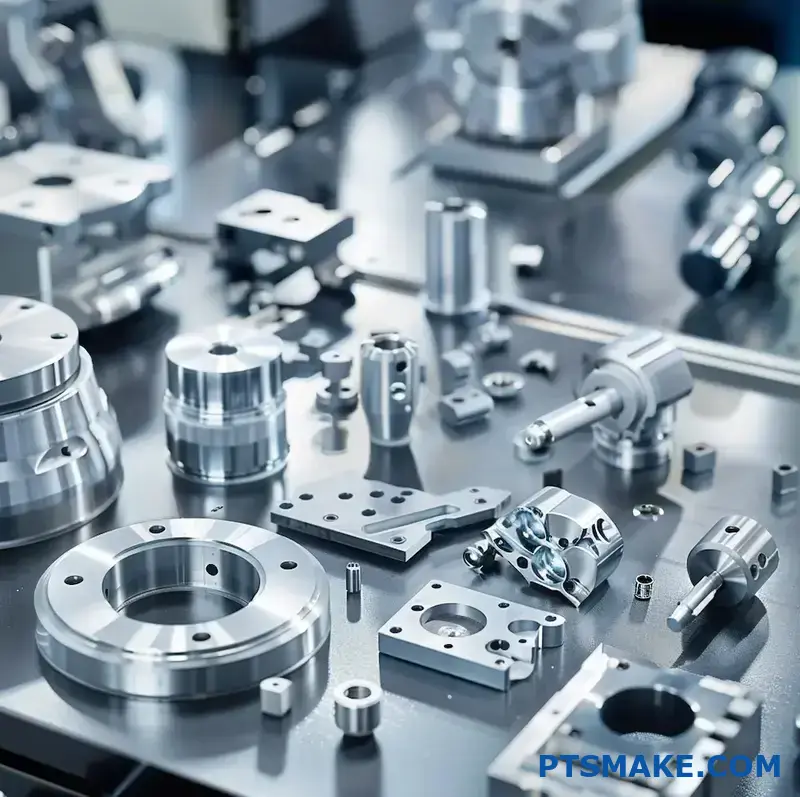
Understanding the Nature of Aluminum 7075
Before diving into the specific machining challenges, it’s important to understand what makes aluminum 7075 unique. This zinc-based alloy contains approximately 5.6% zinc, 2.5% magnesium, 1.6% copper, and small amounts of chromium. These elements combine to create an alloy with exceptional strength-to-weight ratio, but they also contribute to its machining difficulties.
The high strength of 7075 (especially in the T6 temper condition) results in cutting forces that can be significantly higher than those encountered with other aluminum alloys. While not as challenging as titanium or hardened steels, 7075’s mechanical properties place it among the more difficult aluminum alloys to machine.
Primary Machining Challenges with Aluminum 7075
1. Rapid Tool Wear
One of the most common issues when machining aluminum 7075 is accelerated tool wear. The hardness of this alloy (approximately 150 Brinell in the T6 condition) can quickly dull cutting edges, especially when using inappropriate tool materials or geometries.
At PTSMAKE, we’ve found that carbide tooling with specialized coatings significantly extends tool life when machining this alloy. Diamond-coated tools, while more expensive initially, often prove cost-effective for large production runs due to their extended life and reduced downtime for tool changes.
2. Chip Control and Evacuation
Aluminum 7075 tends to produce long, stringy chips that can wrap around the tool or workpiece. These chips not only create safety hazards but can also lead to:
- Re-cutting of chips, which damages the machined surface
- Tool breakage when chips clog flutes
- Increased heat in the cutting zone
- Production delays due to manual chip removal
Proper chip breaker geometry and sufficient coolant pressure are essential for managing this challenge.
3. Built-Up Edge (BUE) Formation
Built-up edge8 formation is particularly problematic with aluminum 7075. During machining, the heat and pressure can cause the workpiece material to adhere to the cutting tool edge, creating a built-up layer that alters the tool geometry. This phenomenon results in:
- Poor surface finish with tearing or smearing
- Dimensional inaccuracies
- Accelerated tool wear
- Inconsistent machining results
4. Heat Management
While aluminum generally has good thermal conductivity, the high cutting forces generated when machining 7075 produce significant heat. This heat must be managed effectively to:
- Prevent workpiece thermal expansion and resultant dimensional issues
- Avoid premature tool wear
- Maintain material properties of the finished part
- Prevent work hardening of the machined surface
Secondary Challenges and Technical Considerations
Dimensional Stability Concerns
The following table outlines specific dimensional stability challenges when machining aluminum 7075:
| Challenge | Cause | Solution |
|---|---|---|
| Thin-wall distortion | Residual stresses, cutting forces | Progressive machining, proper fixturing |
| Thermal expansion | Heat generated during cutting | Effective cooling, appropriate feed rates |
| Post-machining warpage | Residual stress relief | Stress relieving before final machining |
| Thread deformation | Elastic properties of material | Specialized threading techniques, proper lubrication |
Surface Finish Issues
Achieving consistent, high-quality surface finishes on aluminum 7075 can be challenging. The material’s properties can lead to several surface defects:
- Chatter marks: These vibration-induced patterns occur particularly when using extended-reach tooling or insufficient workpiece rigidity.
- Smearing: The material’s ductility can lead to surface smearing rather than clean cutting.
- Feed marks: Improper feed rates can leave visible tool paths that are difficult to remove.
- Surface hardening: Excessive heat or dull tooling can work-harden the surface, making subsequent operations more difficult.
For aerospace and high-performance applications, these surface finish issues aren’t merely cosmetic concerns—they can affect fatigue life, corrosion resistance, and component performance.
Burr Formation
Burr formation is another significant challenge with aluminum 7075. These unwanted projections of material form along edges and can:
- Create safety hazards during handling
- Interfere with assembly processes
- Require costly secondary deburring operations
- Reduce part quality and dimensional accuracy
In my experience at PTSMAKE, implementing deburring strategies directly into the CNC machining process has proven more efficient than separate deburring operations for most 7075 components.
Practical Implementation of Solutions
The key to successfully machining aluminum 7075 lies in addressing these challenges with tailored strategies. Proper tool selection, optimized cutting parameters, suitable coolant application, and appropriate fixturing are all critical elements of an effective machining strategy for this high-performance alloy.
By understanding and preparing for these challenges, manufacturers can efficiently machine aluminum 7075 components with the precision and quality required for aerospace, defense, and other demanding applications.
Can Aluminum 7075 Be Anodized for Corrosion Resistance?
Have you ever invested in high-strength aluminum 7075 components only to watch them deteriorate prematurely in harsh environments? Or perhaps you’ve wondered why some aluminum parts resist corrosion beautifully while your 7075 parts seem more vulnerable despite your best efforts?
Yes, aluminum 7075 can be anodized for corrosion resistance, but with important caveats. While anodizing creates a protective oxide layer that significantly improves corrosion resistance, 7075’s high zinc content makes it more challenging to anodize effectively than other aluminum alloys, requiring specialized processes and careful quality control.
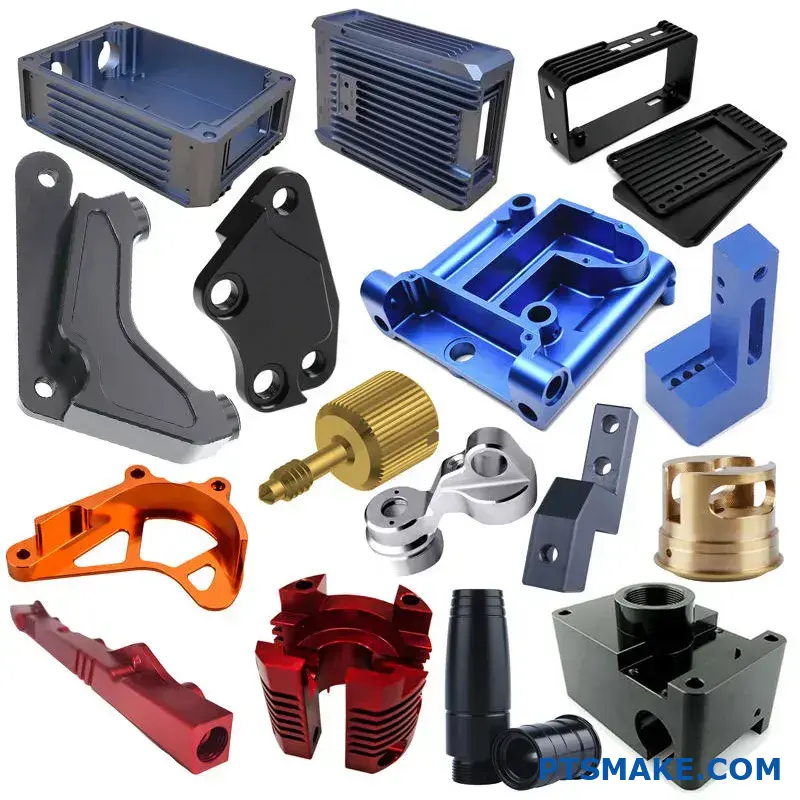
Understanding Anodizing for Aluminum 7075
Aluminum 7075 is widely favored in aerospace, defense, and high-performance applications due to its exceptional strength-to-weight ratio. However, its excellent mechanical properties come with corrosion vulnerability that requires protection, especially in demanding environments.
Anodizing transforms the aluminum surface into a durable, corrosion-resistant oxide layer through an electrochemical process. While this sounds straightforward, aluminum 7075 presents unique challenges during anodizing due to its alloying elements—particularly its high zinc content (5.1-6.1%).
The Chemistry Behind 7075 Anodizing
When anodizing 7075, we’re essentially converting the aluminum surface into aluminum oxide (Al₂O₃). This electrochemical process occurs in an acid electrolyte bath where the aluminum acts as the anode in an electrical circuit. The resulting oxide layer is integrated with the base metal—not just a coating applied on top.
The high zinc content in 7075 affects anodizing in several ways:
- It creates potential irregularities in the oxide layer
- It can lead to microstructural heterogeneity9 in the anodic film
- It often results in a less uniform color after anodizing
- It may reduce the maximum achievable thickness compared to other alloys
Types of Anodizing for 7075 Aluminum
From my experience working with numerous aerospace and defense clients, I’ve found that selecting the right anodizing type significantly impacts the corrosion protection outcome for 7075.
Type I Anodizing (Chromic Acid)
Type I anodizing produces a thin (0.00005" to 0.0001") oxide layer that offers:
- Excellent fatigue resistance
- Good corrosion protection
- Minimal dimensional change
- Superior crack resistance
This makes Type I particularly suitable for aircraft components where fatigue properties cannot be compromised.
Type II Anodizing (Sulfuric Acid)
Type II creates a medium thickness film (0.0001" to 0.001") and provides:
- Good corrosion resistance
- Better wear resistance than Type I
- Ability to accept dyes
- Cost-effective processing
Type III (Hard) Anodizing
Type III results in the thickest oxide layer (0.001" to 0.004") with:
- Superior wear resistance
- Enhanced corrosion protection
- Excellent hardness
- Greater dimensional change
Here’s a comparison of the different anodizing types for 7075:
| Anodizing Type | Oxide Layer Thickness | Corrosion Resistance | Wear Resistance | Fatigue Strength Impact | Best Applications |
|---|---|---|---|---|---|
| Type I (Chromic) | 0.00005" – 0.0001" | Good | Low | Minimal | Aircraft components, fatigue-critical parts |
| Type II (Sulfuric) | 0.0001" – 0.001" | Better | Moderate | Moderate | General-purpose applications, decorative uses |
| Type III (Hard) | 0.001" – 0.004" | Best | Excellent | Significant | Wear surfaces, harsh environments |
Anodizing Challenges Specific to 7075
At PTSMAKE, we’ve overcome several challenges when anodizing 7075 components for our clients. The most common issues include:
1. Surface Preparation Requirements
7075 demands meticulous surface preparation. Any contaminants, machining marks, or scratches become magnified after anodizing. This requires:
- Multi-stage cleaning processes
- Proper degreasing
- Controlled etching parameters
- Careful handling between processes
2. Heat Treatment Considerations
The temper condition of 7075 significantly impacts anodizing results. Parts in the T6 or T651 temper generally anodize well, while other tempers may produce less consistent results. When anodizing 7075, we must consider:
- The specific temper condition
- Potential hydrogen embrittlement
- Effects of anodizing temperature on mechanical properties
- Post-anodizing heat treatments when necessary
3. Sealing Methods for Enhanced Protection
The sealing process after anodizing is crucial for maximizing corrosion resistance. For 7075, I recommend:
- Hot water sealing for general applications
- Nickel acetate sealing for enhanced protection
- Sodium dichromate sealing for maximum corrosion resistance
- PTFE-based sealers for applications requiring lubricity
Real-World Performance of Anodized 7075
In my experience manufacturing precision components, anodized 7075 performs exceptionally well in many environments but has limitations. Here’s what I’ve observed:
- Salt Spray Testing: Properly anodized and sealed 7075 typically withstands 336+ hours in salt spray testing per ASTM B117, though this is less than some other aluminum alloys.
- Coastal Environments: Additional protection layers are often needed for prolonged coastal exposure.
- Industrial Atmospheres: Anodized 7075 generally performs well but requires periodic inspection.
- Field Performance: Regular maintenance extends the protective life significantly.
Best Practices for Anodizing 7075
To achieve optimal corrosion resistance when anodizing aluminum 7075:
- Design with anodizing in mind: Avoid sharp corners, blind holes, and inaccessible areas.
- Specify the right process: Match the anodizing type to the application requirements.
- Control alloy variability: Use consistent material sources when possible.
- Consider supplemental protection: Apply sealants or topcoats for extreme environments.
- Establish proper testing protocols: Verify protection through appropriate test methods.
How to Choose Between Aluminum 7075 and Titanium Alloys?
Ever found yourself staring at material specs, caught between aluminum 7075 and titanium alloys for your critical project? The wrong choice could mean wasted budget, performance issues, or even component failure when it matters most.
Choosing between aluminum 7075 and titanium alloys depends on your specific application requirements. Aluminum 7075 offers excellent strength-to-weight ratio at lower cost, while titanium alloys provide superior strength, corrosion resistance, and temperature performance at a premium price.

Understanding Material Properties
Strength Comparison
When selecting between aluminum 7075 and titanium alloys, strength characteristics are often the starting point. Aluminum 7075 is one of the strongest aluminum alloys available, with a tensile strength ranging from 70-83 ksi (483-572 MPa) when properly heat treated. It’s significantly stronger than many other aluminum alloys, which is why it’s so popular in aerospace applications.
Titanium alloys, particularly Ti-6Al-4V (Grade 5), offer tensile strengths of 120-170 ksi (830-1172 MPa), making them substantially stronger than aluminum 7075. This exceptional strength allows titanium components to withstand higher loads in critical applications where failure isn’t an option.
Weight and Density
One of the most significant differences between these materials is their density. Aluminum 7075 has a density of approximately 2.81 g/cm³, while titanium alloys typically range from 4.43-4.85 g/cm³. This means titanium is about 60% heavier than aluminum 7075 for the same volume.
However, when considering the specific strength10 – the strength-to-weight ratio – both materials perform exceptionally well. Aluminum 7075’s lower density often makes it preferable for applications where weight savings are critical, such as aircraft structures and high-performance automotive components.
Corrosion Resistance
In my experience working with precision components at PTSMAKE, corrosion resistance can make or break a project’s success. Titanium alloys naturally form a stable, protective oxide layer that provides exceptional corrosion resistance in most environments, including saltwater and many aggressive chemicals.
Aluminum 7075, while strong, is more vulnerable to corrosion, particularly stress corrosion cracking and exfoliation corrosion in certain environments. It typically requires additional surface treatments like anodizing or alodining to enhance its corrosion resistance.
Cost Considerations
The price difference between these materials is substantial and often becomes a deciding factor:
| Material | Relative Cost | Machining Cost | Availability |
|---|---|---|---|
| Aluminum 7075 | $ | Lower | Excellent |
| Titanium Alloys | $$$$ | Higher | Good |
Titanium alloys typically cost 5-10 times more than aluminum 7075 per unit weight. The high cost stems from complex extraction processes and the energy required to refine titanium ore. Additionally, titanium is harder to machine, requiring specialized tooling, slower cutting speeds, and more frequent tool changes, further increasing production costs.
At PTSMAKE, we’ve found that carefully evaluating cost versus performance requirements helps clients avoid overspending when aluminum 7075 would suffice for their application.
Temperature Performance
High-Temperature Applications
Titanium alloys maintain their mechanical properties at much higher temperatures than aluminum 7075. While aluminum 7075 begins to lose strength significantly above 200°F (93°C), many titanium alloys can operate effectively up to 1000°F (538°C).
This temperature resistance makes titanium the clear choice for components exposed to high temperatures, such as aircraft engine parts, exhaust components, and high-performance automotive applications.
Low-Temperature Performance
Both materials perform well at low temperatures. Unlike some metals that become brittle, aluminum 7075 and titanium alloys maintain good ductility and toughness even at cryogenic temperatures. This makes both viable options for aerospace applications and equipment operating in extreme cold.
Application-Specific Selection Criteria
Aerospace Applications
In aerospace, the strength-to-weight ratio is paramount. Aluminum 7075 has historically been the backbone of aircraft structures, particularly in fuselage frames, wings, and structural components. Its combination of high strength, relatively low cost, and excellent machinability makes it ideal for many aerospace applications.
Titanium alloys are reserved for critical components where their unique properties justify the cost premium:
- Engine components exposed to high temperatures
- Landing gear components requiring exceptional strength
- Structural elements in high-stress areas
Medical Applications
For medical implants and surgical instruments, titanium’s biocompatibility, corrosion resistance, and non-magnetic properties make it irreplaceable. Aluminum, including 7075, is generally not suitable for implantable devices due to biocompatibility concerns.
Sporting Equipment
Both materials find applications in high-performance sporting equipment. Aluminum 7075 is commonly used in bicycle frames, baseball bats, and tent poles where its strength and light weight provide performance advantages at a reasonable cost.
Titanium alloys appear in premium sports equipment like golf clubs, tennis rackets, and high-end bicycle components where performance justifies the higher price point.
Fabrication Considerations
Through our manufacturing experience at PTSMAKE, I’ve observed that material selection significantly impacts manufacturing processes:
Machining Differences
Aluminum 7075 machines exceptionally well, allowing for complex geometries and thin walls with relatively fast cutting speeds. This translates to lower production costs and shorter lead times.
Titanium alloys present significant machining challenges:
- Require slower cutting speeds (typically 1/5 to 1/10 of aluminum)
- Generate high cutting temperatures
- Cause rapid tool wear
- Require specialized cutting tools and coolants
These factors can increase machining costs by 3-5 times compared to aluminum for the same component.
Learn how different aluminum alloys affect your part’s longevity and performance under repeated stress. ↩
Learn about how this property affects material selection for critical defense applications. ↩
Learn how this property affects your material selection decisions. ↩
Click to learn more about how this process enhances 7075’s strength properties. ↩
Click here to learn how to prevent costly material failures in your projects. ↩
Learn about prevention methods and treatment for this occupational illness. ↩
Learn how this strengthening mechanism affects your parts’ performance. ↩
Click to learn advanced techniques for preventing BUE when machining aluminum alloys. ↩
Learn about this complex metallurgical concept to improve your part designs. ↩
Learn about material strength-to-weight ratios and optimization techniques for your projects. ↩



